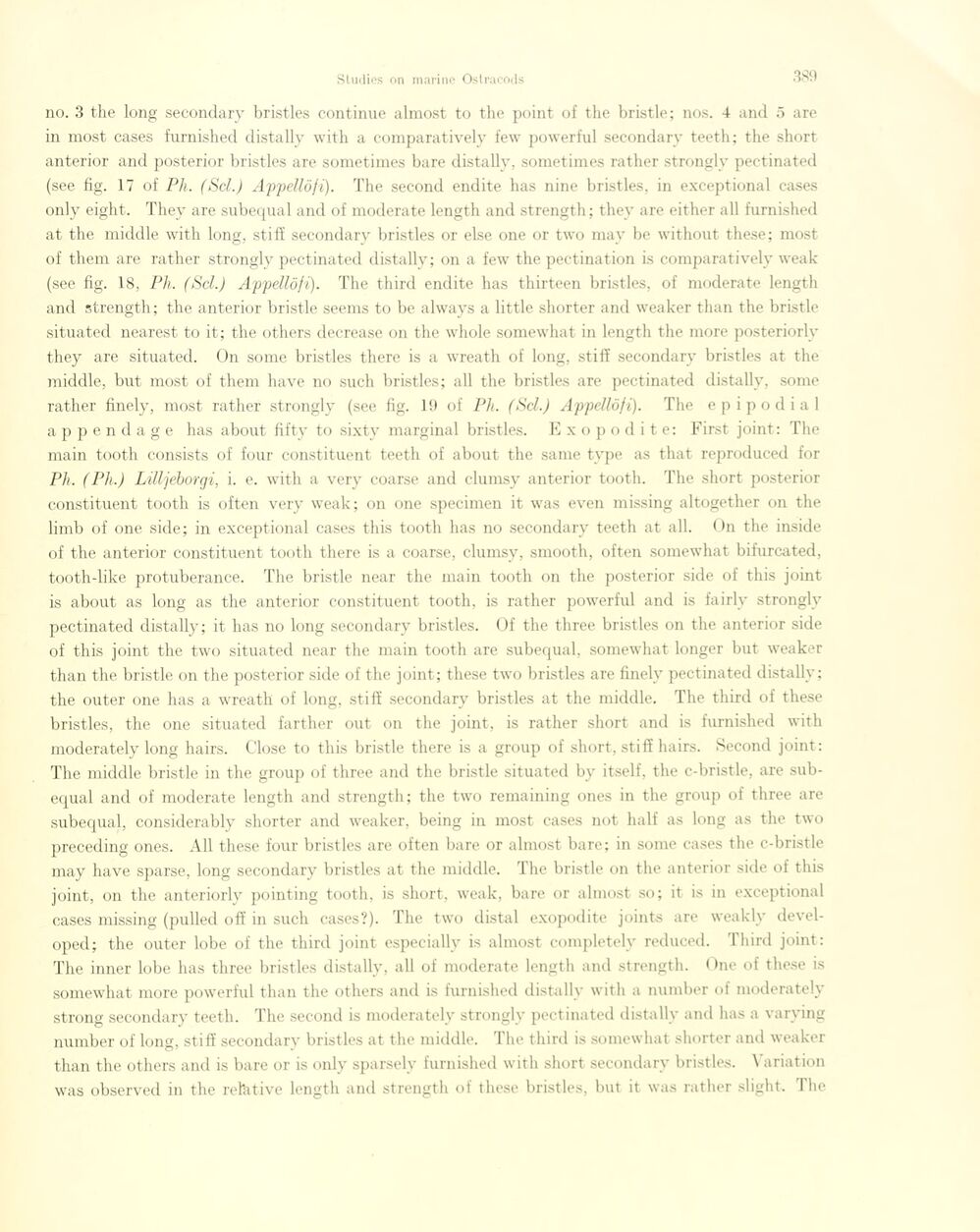
Full resolution (JPEG) - On this page / på denna sida - Sidor ...

<< prev. page << föreg. sida << >> nästa sida >> next page >>
Below is the raw OCR text
from the above scanned image.
Do you see an error? Proofread the page now!
Här nedan syns maskintolkade texten från faksimilbilden ovan.
Ser du något fel? Korrekturläs sidan nu!
This page has never been proofread. / Denna sida har aldrig korrekturlästs.
no. 3 the long secondary bristles continue almost to the point of the bristle; nos. 4 and 5 are
in most cases furnished distally with a comparatively few powerful secondary teeth; the short
anterior and posterior bristles are sometimes bare distally, sometimes rather strongly pectinated
(see fig. 17 of Ph. (Sel.) Appellöfi). The second endite has nine bristles, in exceptional cases
only eight. They are subequal and of moderate length and strength; they are either ail furnished
at the middle with long, stift secondary bristles or else one or two may be without these; most
of them are rather strongly pectinated distally; on a few the pectination is comparatively weak
(see fig. 18, Ph. (Sel.) Appellôfï). The third endite lias thirteen bristles, of moderate length
and strength; the anterior bristle seems to be always a little shorter and weaker than the bristle
situated nearest to it; the others decrease on the wliole somewhat in length the more posteriorlv
they are situated. On some bristles there is a wreath of long, stift secondary bristles at the
middle, but most of them have no such bristles; all the bristles are pectinated distally, some
rather finely, most rather strongly (see fig. 1!) of Ph. (Sd.) Appellöfi). The epi podia 1
appendage has about fifty to sixty marginal bristles. Exopodite: First joint: The
main tooth consists of four constituent teeth of about the same type as that reproduced for
Ph. (Ph.) Lüljeborgi, i. e. with a very coarse and clumsy anterior tooth. The short posterior
constituent tooth is often very weak; on one specimen it was even missing altogether on the
limb of one side; in exceptional cases this tooth has no secondary teeth at all. On the inside
of the anterior constituent tooth there is a coarse, clumsy, smooth, often somewhat bifurcated,
tooth-like protubérance. The bristle near the main tooth on the posterior side of this joint
is about as long as the anterior constituent tooth, is rather powerful and is fairly strongly
pectinated distally; it lias no long secondary bristles. Of the three bristles on the anterior side
of this joint the two situated near the main tooth are subequal. somewhat longer but weaker
than the bristle on the posterior side of the joint; these two bristles are finely pectinated distally;
the ou ter one has a wreath of long, stift secondary bristles at the middle. The third of these
bristles, the one situated farther out on the joint, is rather short and is furnished with
moderately long hairs. Close to this bristle there is a group of short, stift hairs. Second joint:
The middle bristle in the group of three and the bristle situated by itself, the c-bristle, are
subequal and of moderate length and strength; the two remaining ones in the group of three are
subequal, considerably shorter and weaker, being in most cases not half as long as the two
preceding ones. Ail these four bristles are often bare or almost bare; in some cases the c-bristle
may have sparse, long secondary bristles at the middle. The bristle on the anterior side of this
joint, on the anteriorly pointing tooth. is short, weak, bare or almost so; it is in exceptional
cases missing (pulled off in such cases?). The two distal exopodite joints are weakly
devel-oped; the outer lobe of the third joint especially is almost completely reduced. Third joint:
The inner lobe has three bristles distally, all of moderate length and strength. One of these is
somewhat more powerful than the others and is furnished distally with a number of moderately
strong secondary teeth. The second is moderately strongly pectinated distally and has a varving
number of long, stift secondary bristles at the middle. The third is somewhat shorter and weaker
than the others and is bare or is only sparsely furnished with short secondary bristles. Variation
was observed in the relative length and strength of these bristles, but it was rather slight. The
<< prev. page << föreg. sida << >> nästa sida >> next page >>